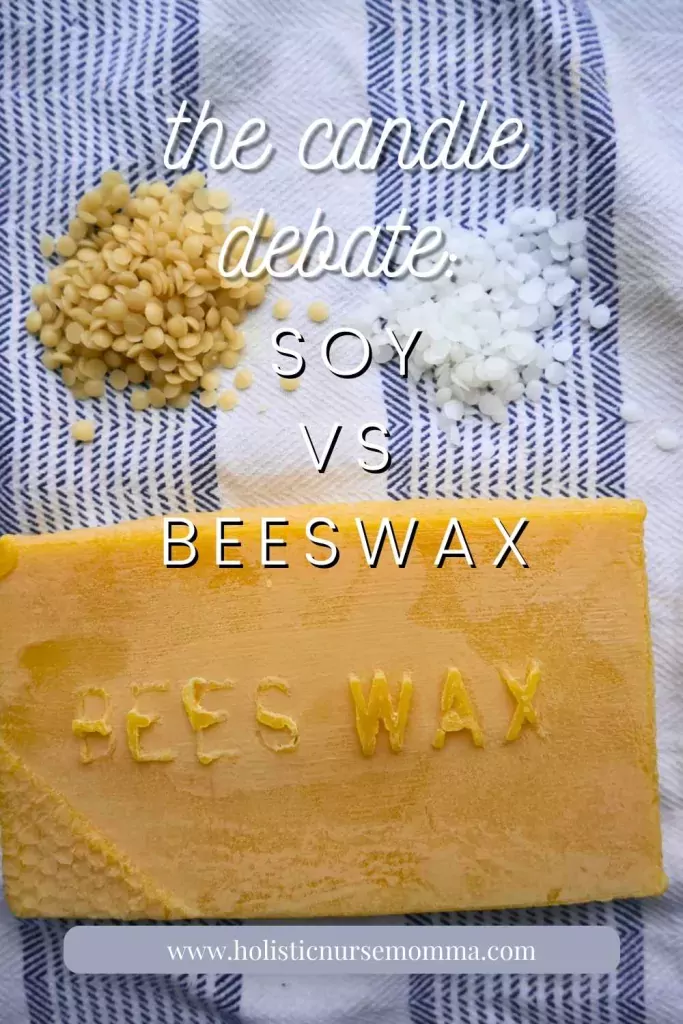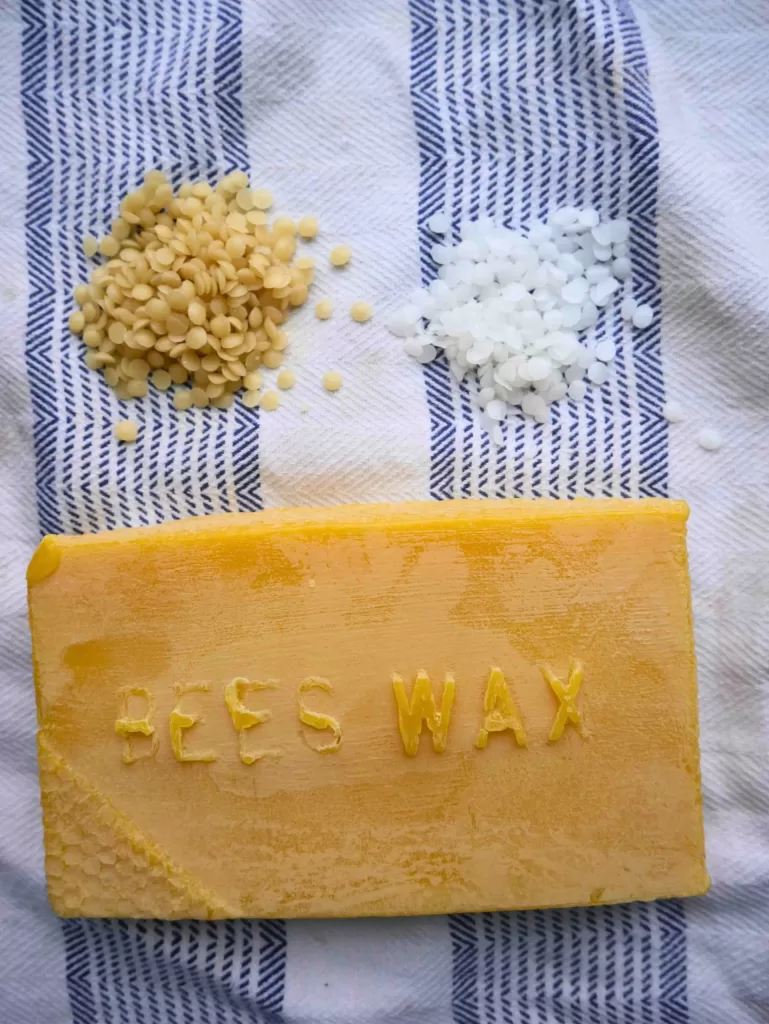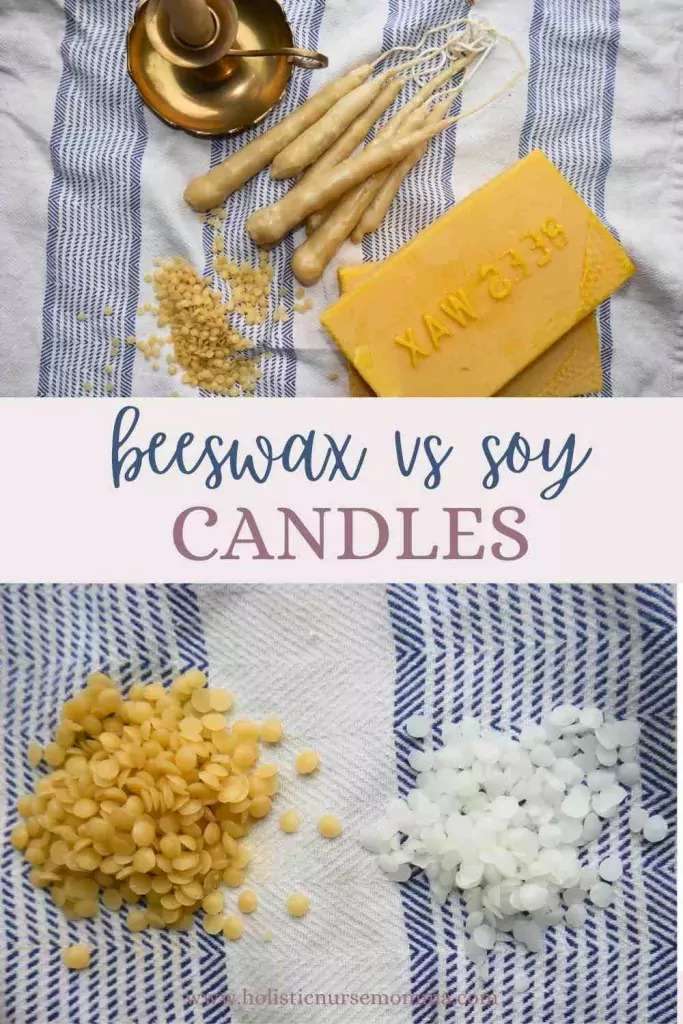Ditching toxins can get exhausting and candles can be hidden culprit within your home. Many have concerns with traditional paraffin candles and if they are bad for lung health. To top if off, they are usually scented with synthetic fragrance too. So what are the alternatives? Today I am going to dive into the soy wax candles vs beeswax candles debate!
This is not a post to bash soy wax. As you will see, at the end of the day, it is really up to your personal preferences on which wax to use.

the main differences between soy candles and beeswax candles
Always do your own research, but on my toxin free journey, here are some things that I have discovered along the way. If you are wanting to learn more about ditching toxins in your home, check out my series on switching to a toxin free home here.
health
My family’s health is one of the biggest reasons I have gone through periods of avoiding candles altogether. Once I learned that many candles were made with synthetic fragrances (hello headaches!) and traditional paraffin wax, I jumped ship altogether. I found wax melts to be slightly safer because they did not burn and I was not as concerned with volatile organic compounds (VOCs) since I opted for ones made without fragrance oils. These harmful chemicals are terrible for pet and human health and can be found in paints, air fresheners, tobacco smoke, and more.
Beeswax and soy wax candles are a safer alternative for those concerned about their family’s health too. Some who may have environmental allergies, asthma, or other sensitivities may find that beeswax or soy wax candles do not have the effects on them as paraffin wax candles do. In recent years, some have been concerned that paraffin wax gives off toxic chemicals when burned.
Traditional paraffin wax candles tend to leave behind black soot. Beeswax and soy burn off less soot, making the air in your home cleaner.
If you or a loved one do have these sensitivities, consider unscented beeswax candles or candles scented with essential oils.

environmental
Soy wax is a vegetable wax. It is made from the soy bean. When you press this bean, you get an oil. This oil is then hydrogenated to get hydrogenated soybean oil or soy wax. This process is similar to how you would get coconut wax.
From soy beans, other soy products are also produced.
One concern for some is, how was the original soy bean grown? Were chemical fertilizers and pesticides involved? Was an area clear cut to fit in the soy field? The environmental impact of the soy industry manifests in several ways, ranging from deforestation to biodiversity loss and carbon emissions.
Beeswax on the other hand is natural form of wax and you could possibly make it on your own. If you have raw honeycomb, you could potentially make your own beeswax similar to how you would make tallow or lard. This is a very simplified explanation, but you put the honey comb in a pot filled with water. You would keep the pot at a simmer then strain apart your liquids from your solids. Then repeat this process to strain off the last impurities and allow it to harden and separate from water.

the impact on the bees
Some might argue that the worker bees and hive workers are negatively affected by producing beeswax. But from my personal experience, the bee keeps I know want to ensure their bee colonies are healthy and continue to produce pounds of honey, propolis, and beeswax.
Another bee argue I have heard is that bringing in honey hives can cause the native, wild bees to have more competition. I enjoy watching bees from what I observe, they are in no way collecting all the pollen and nectar in my area. So yes, they can be competing for the same resources, but each time a new bee lands it seems to always get some pollen on them from our plants that are around.
burning
You may want to pick the type of wax you use off how well it burns. Based off of what others are saying on the internet, beeswax has a longer burn time compared to soy. But when compared to paraffin, soy has a longer burn time.This makes sense as beeswax has a high melting point when compared to the other two.
There are factors that affect these times, but when comparing waxes made to the same thickness and using the same wicks, this is what has been found. Since soy tends to be a softer wax, it does not do as well for dipped candles.
A clean burning candle may also be what you want to consider for your indoor air quality. But, according the National Candle Association, there actually have not been peer reviewed studies to show that soy or beeswax burns any cleaner than paraffin. This may be the case, but I will prefer to still opt for the natural waxes.

scents
If you are wanting to make scented container candles to use around your home, beeswax may not be the best choice. Although it will burn longer, if you want a scented candle, soy wax comes out on top. Soy wax tends to produce a more pleasant scent when fragrances or essential oils are added.
If you want to use beeswax, it is better suited to allow its natural scent into the air.
versatility
Both soy and bees wax can be used in a variety of other products. I tend to enjoy using beeswax in my DIYs such as lip balms and vapor rubs since I already have them around from making dipped candles.

coloring
Although raw beeswax is naturally yellow, you can find white beeswax that has been melted and strained more. Both wax types, soy and beeswax, allow you to add colors if you want.
cost
Even though beeswax is less processed and you get other delicious benefits from a hive, that does not drive down cost. When it comes to eco-friendly candle options, beeswax tends to cost more than soy wax.
final considerations
What it really comes down to is your personal preference when comparing beeswax vs soy wax. The type of candle wax you use will be up to your goals. One thing to consider no matter the type of wax you choose is to make sure you do not burn the candle than a few hours at a time. Make sure that wherever you burn your candles, there is good ventilation. This will make it better for your indoor air quality.
You may also want to make your consideration on the production process of each wax, the scent throw, and comparing how long burn times are. I know which I enjoy using for our candles, but I would love to hear which you use and why.
For me, I will stick with beeswax for now. But we enjoy making them mainly as dipped candles and for the longer burn time!


Leave a Reply